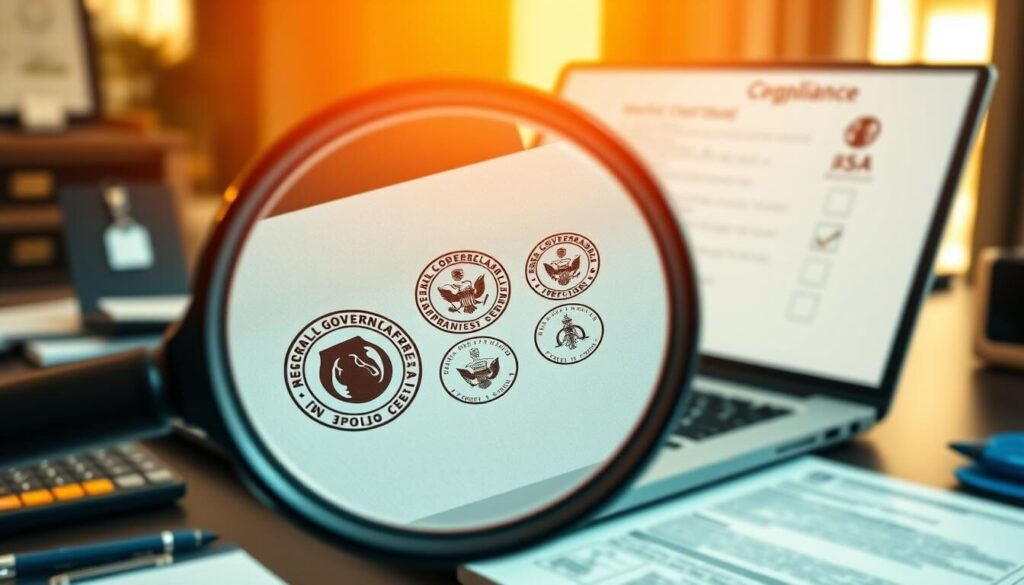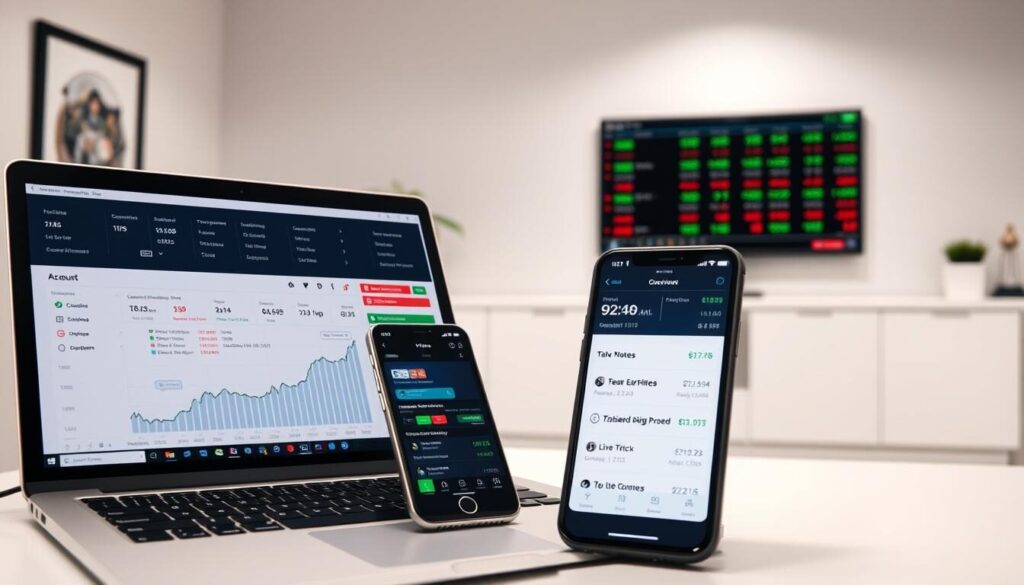Imagine losing $528 million in a single scam. That’s exactly what happened in the Raymond J. Pirrello case—a stark reminder that even in 2024, fake brokers can drain wallets faster than a broken faucet. And here’s the kicker: over 30% of traders still don’t check if their broker is legit before investing. Oof.
Why does this matter? Think of it like untangling headphone wires. Skip a step, and you’re stuck with a mess. We’ll walk you through exactly what to look for—from decoding regulatory filings to spotting sneaky red flags. No jargon, just straight talk.
Regulators like the SEC and FINRA have cracked down hard, but scammers keep evolving. This guide pulls back the curtain on their tricks, using real enforcement data and lessons from historical blowups. You’ll learn how to:
- Spot fake registration claims
- Decode broker background checks
- Use tools like BrokerCheck without getting lost in bureaucracy
We’ve organized everything into bite-sized sections (check the table of contents—it’s your roadmap). By the end, you’ll navigate broker verification like a pro. Let’s turn that anxiety into action.
Key Takeaways
- Fraudulent brokers stole over half a billion dollars in recent cases
- FINRA’s BrokerCheck reveals registration and disciplinary history
- Legit U.S. brokers must have CFTC registration and NFA membership
- SIPC insurance protects up to $500,000 per account
- Domain age checks expose fake “established” brokers
- Pressure tactics and guaranteed returns are major red flags
Understanding the Importance of Broker Legitimacy
Bernie Madoff’s $65 billion Ponzi scheme didn’t start with a neon “scam” sign. It began with trust—the kind that makes you hand over your life savings to someone who seems legit. Like ordering sushi from a food truck: if the health grade isn’t visible, you’re gambling with more than your appetite.
Impact on Your Investments and Trading Experience
Legit brokers act like shock absorbers for your portfolio. They’re required to keep client funds in separate accounts—think of it as a fireproof safe for your cash. Unregulated ones? That’s like storing gold bars in a cardboard box during hurricane season.
| Legit Broker | Scam Broker |
|---|---|
| SEC/FCA regulated | Offshore registration |
| Clear fee structure | Hidden charges |
| Segregated accounts | Co-mingled funds |
The Risk of Fraudulent Practices in Forex Trading
Jordan Belfort (“Wolf of Wall Street”) didn’t need magic tricks to drain accounts—just smooth talk and fake urgency.
“The best way to make money is to make other people money first.”
Except when they’re making it disappear.
Even licensed companies can pull shady moves. Remember: SIPC insurance covers up to $500k if things go south. No broker wants you knowing that stat—it’s like a restaurant admitting their burgers might give you food poisoning.
The bottom line? Your money’s safety isn’t a maybe. It’s the foundation of every smart trading decision. Treat broker checks like checking your parachute before skydiving—skip it, and the market’s concrete floor comes fast.
How to Verify If a Forex Broker Is Legitimate: Starting Your Due Diligence

Picture this: You wouldn’t buy a used car without checking its Carfax. Yet 43% of traders skip this basic step when choosing who handles their money. That’s like handing your keys to a stranger who says “Trust me, I’m a mechanic”—while their shop’s on fire.
Why Proper Research Matters
Solid research is your financial seatbelt. In 2020, Interactive Brokers got slapped with a $38 million fine for compliance failures. Investors who checked BrokerCheck first? They dodged that bullet. The pattern’s clear: every minute spent verifying pays in risk reduction.
Start with these steps:
- Google “[Broker Name] + scam” – see what pops up
- Compare their claimed credentials against regulator websites
- Dig through independent news archives
Overview of Essential Verification Steps
Think of due diligence as financial detective work. First stop: FINRA’s BrokerCheck. Type in the firm’s name—you’ll see registration status faster than a TikTok scroll. Look for green flags like “Active/Approved” and red ones like “Pending Investigation”.
Next, play document detective. Legit businesses provide clear performance histories—if their “About Us” page reads like a spy novel with missing chapters, walk away. One FX firm’s “20 years of experience” claim crumbled when domain records showed they’d registered the site 6 months prior.
Remember: Scammers hate paper trails. Your best weapons? Regulatory databases and healthy skepticism. Up next—we’ll break down how to decode those intimidating government registrations like a pro.
Evaluating Regulatory Credentials and Enforcement Standards

Navigating broker regulations feels like decoding tax forms blindfolded—until you know where to look. Think of regulatory credentials as a restaurant’s health inspection score: if it’s not prominently displayed, assume the kitchen’s crawling with roaches.
Utilizing FINRA’s BrokerCheck and Regulatory Databases
BrokerCheck is your financial background checker. Type a firm’s name into FINRA’s free tool—it’s faster than Googling cat memes. Look for three green lights: active registration, clean disciplinary history, and real physical addresses. Red flags? “Pending investigation” or offshore headquarters listed as a P.O. box in the Bahamas.
Here’s the kicker: some firms claim SEC registration but only have state-level approvals. Cross-reference using the SEC’s IAPD database—it’s like checking a car’s VIN against its dealership paperwork. One FX company bragged about CFTC oversight until someone noticed their NFA ID linked to a closed yogurt shop in Delaware.
Understanding Registration with SEC, NFA, and CFTC
Legit firms wear multiple regulatory hats. The SEC oversees securities, while the NFA polices commodity futures trading. CFTC registration? Non-negotiable for forex brokers—it’s the gold standard for exchange oversight. Check all three like you’re verifying a Tinder date’s LinkedIn, Instagram, and… well, arrest records.
| Regulator | Role | Oversight Area |
|---|---|---|
| SEC | Securities cop | Stocks, ETFs |
| NFA | Futures watchdog | Commodity trades |
| CFTC | Forex sheriff | Currency markets |
Enforcement actions scream “trouble.” The SEC fined a major platform $10 million last year for hiding fees—details buried in their EDGAR filings. Your move? Treat regulatory databases like Yelp reviews for money handlers. No approvals? Swipe left.
Assessing Communication and Client Service Quality

Hiring a broker without a proper interview? That’s like swiping right on a dating profile that lists “professional breath-holder” as their job. You need real answers, not creative fiction. Client service quality separates trustworthy brokers from polished cons—it’s the difference between a Michelin-star meal and gas station sushi.
Interviewing Brokers and Asking the Right Questions
Treat your first broker call like a job interview—you’re the CEO. Ask about fees upfront: “What’s the commission on EUR/USD trades?” Watch for waffling. Legit companies provide clear numbers faster than a TikTok trend.
Red flags pop up when they:
- Dodge questions about past performance (“Our strategies are proprietary!”)
- Push you to deposit before explaining withdrawal policies
- Respond slower than dial-up internet during market hours
Here’s a pro move: Call their support line twice. First at 9 AM New York time, then during Asian trading hours. Reliable services answer in under two minutes—both times. One FX firm’s “24/7 support” turned out to be a single intern working from a Bali hostel.
| Green Flags | Red Flags |
|---|---|
| Explains slippage risks clearly | “Trust me, bro” energy |
| Provides fee breakdown in writing | Vague answers about order execution |
| Offers multiple contact methods | Only has a WhatsApp number |
Compare three brokers minimum. The middle one usually reveals industry standards—like realizing most restaurants charge for extra guac. Your investment security starts with this line of questioning. No shortcuts.
Researching Broker Background and Disciplinary History
Digging into a broker’s past is like swiping through dating app red flags—skip the profile polish, find the real story. Start with three tabs open: forums, news archives, and regulatory databases. This trifecta reveals patterns faster than binge-watching true crime docs.
Checking Online Reviews and News Reports
Reddit’s r/Forex threads spill more tea than a reality TV reunion. Search “[Broker Name] + withdrawal issues”—if multiple users report “processing delays”, that’s your cue to exit stage left. One firm’s five-star Trustpilot reviews crumbled when someone noticed all accounts were created the same week.
News archives matter. The CFTC fined a currency platform $1.5 million last year for inflating profits claims—details buried in page 16 of local business journals. Pro tip: Set Google Alerts for your broker’s name + “lawsuit” or “settlement”.
| Info Source | Reliable Example | Sketchy Example |
|---|---|---|
| Forums | 10+ users confirming fast withdrawals | Identical positive comments posted hourly |
| News | Mentions in Bloomberg/Reuters | Only press releases on their own site |
| Regulatory | Clean NFA BASIC record | “Not registered” status on CFTC site |
Investigating Past Enforcement Actions and Complaints
FINRA’s BrokerCheck shows more drama than a Netflix docuseries. Look for repeat offenders—one firm had 12 “unsuitable investment” complaints in three years. Their excuse? “Clients misunderstood the risks.” Sure, and my dog ate the compliance manual.
Even big players slip up. A major foreign exchange broker paid $6 million in 2022 for hiding trading system flaws. Their marketing still brags about “transparent operations”. Always cross-check:
- SEC litigation releases
- NFA disciplinary archives
- BBB complaint histories
Remember: Clean records today don’t guarantee safety tomorrow. But a history of enforcement actions? That’s like seeing “Final Notice” stickers on a used car—proceed with industrial-strength caution.
Verifying Financial Security Measures and SIPC Membership

Your money’s safety net has more holes than Swiss cheese if you skip this step. SIPC insurance works like a financial seatbelt—useless until you crash. Here’s the twist: forex trading accounts aren’t covered by this protection. That’s why smart traders double-check both the policy and the fine print.
Confirming SIPC and Additional Insurance Coverage
Think of SIPC as a $500,000 safety net for securities accounts. Legit brokers display their membership number like a badge of honor—usually in the footer of every page. No visible ID? Red flag alert. Use SIPC’s online search tool to confirm their status faster than you can say “Where’s my money?”
Here’s what matters:
- Segregated accounts keep your funds separate from the broker’s operating money
- Additional insurance policies fill gaps where SIPC doesn’t apply (looking at you, forex trades)
- Anti-money laundering compliance isn’t optional—it’s the law
| Protection Type | Covers Forex? | Max Coverage |
|---|---|---|
| SIPC | ❌ | $500k |
| Excess SIPC | ❌ | $150M+ |
| Broker-specific insurance | ✅ | Varies |
Retail traders often get bamboozled here. One firm claimed “full SIPC coverage” while quietly routing forex trades through an uninsured subsidiary. Always ask: “Where’s my money actually held?” The answer should include a major bank name, not “trust us.”
Pro tip: Dial (202) 371-8300—SIPC’s hotline—to verify shady claims. Takes two minutes. Saves years of regret.
Monitoring Account Activity and Trading Statements

Reviewing trading statements is like checking your restaurant bill—skip the fine print, and you might pay for someone else’s champagne. One trader discovered a $2,000 “platform fee” hidden in account content—turned out their broker was using client funds to fund office parties. Yikes.
Treat every line item like a suspicious text from an ex. That $4.72 discrepancy? Could be a rounding error—or the first breadcrumb in a money laundering scheme. Pro tip: Set calendar alerts to review statements weekly. Your future self will thank you when spotting unauthorized trades faster than a TikTok scroll.
Importance of Regular Statement Reviews
Scammers thrive on chaos. One FX firm delayed statements for months—then vanished with $12 million. Here’s the kicker: clients who checked daily balances through third-party apps noticed missing funds weeks earlier. Be that person.
| Real Activity | Fake Activity |
|---|---|
| Consistent trade timestamps | Trades dated weekends/holidays |
| Matching bid-ask spreads | Wildly fluctuating spreads |
| Clear fee breakdowns | “Miscellaneous charges” entries |
Use tools like SEON to track account movements in real time. One user spotted a $500 withdrawal they didn’t authorize—turns out their broker had a “helpful” auto-sweep feature siphoning cash to an offshore account. Always verify:
- Trade execution prices vs. market data
- Withdrawal processing times
- Interest calculations on margin balances
Remember: Your money tells stories. Read between the lines—literally. That “account maintenance fee” increasing every month? Might be financing someone’s yacht habit.
Identifying Red Flags and Common Forex Scams
Scams in currency markets work like bad Tinder dates—all charm upfront, ghosting when you ask real questions. That gut feeling when “guaranteed 300% returns” pop up in your DMs? Listen to it. Fraudsters spent $4.3 billion on forex schemes last year—enough to buy Twitter’s headquarters twice.
Cold Calls and Robot Miracles
Signal sellers and trading bots flood forums with screenshots of Lamborghinis and beach villas. Reality check: One “AI-powered robot” turned $10k into $87 in three weeks—then demanded $500/month subscription fees. These operations often:
- Claim secret algorithms “used by Wall Street insiders”
- Pressure you to act before “the offer expires”
- Disable withdrawal options after deposits
| Legit Service | Scam Alert |
|---|---|
| Transparent fee structure | Hidden subscription charges |
| Verified user testimonials | Fake Reddit accounts praising results |
| Free trial periods | Upfront payment demands |
Reviews Don’t Lie (Usually)
Check client feedback like you’re vetting a new babysitter. One FX firm had 47 five-star reviews—all posted within 24 hours by accounts named “User1234.” Cross-reference:
- BBB complaint histories
- SEC enforcement actions
- Independent news investigations
The bottom line? If an Instagram trader’s bio reads “Retired at 25” but their domain was registered last Tuesday, run. Legit businesses welcome scrutiny—scammers hate sunlight.
Conclusion
Ever wonder why some traders sleep soundly while others check their accounts hourly? The difference often boils down to one thing: bulletproof verification habits. Treat broker due diligence like a daily vitamin—skip it, and your financial health risks collapse.
Start with the basics. Cross-reference regulatory IDs using the CFTC database—legit firms wear their credentials like a badge. Bookmark FINRA’s BrokerCheck; it’s your financial lie detector. And never underestimate the power of a simple domain age check. One “established” firm’s website was registered three weeks before targeting retirees—this legit broker checklist exposes those tricks fast.
Your money’s safety isn’t a one-and-done deal. Revisit client reviews quarterly. Scan for new enforcement actions monthly. Track withdrawal speeds like you’d monitor a suspicious mole. Scammers evolve, but your vigilance can outpace them.
Remember: Forex trading thrives on trust, but blind faith belongs in fairy tales. Use every tool covered here—from SIPC verification to mobile trading tools that flag odd activity. Spot a red flag? Walk away faster than a dropped mic.
Now go forth—armed with sharper checks than a Michelin inspector. Your future self will high-five you during tax season. Sleep well, trade smarter, and let the scammers starve.
